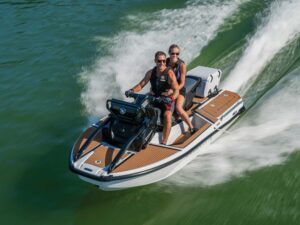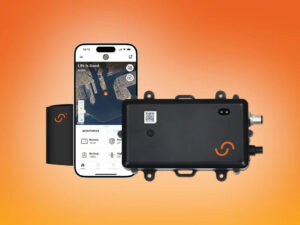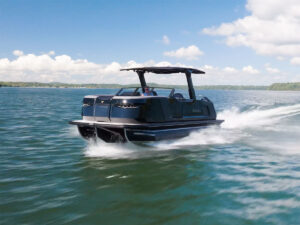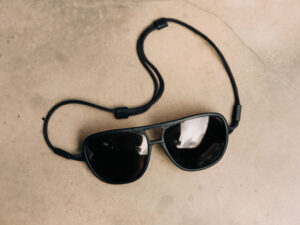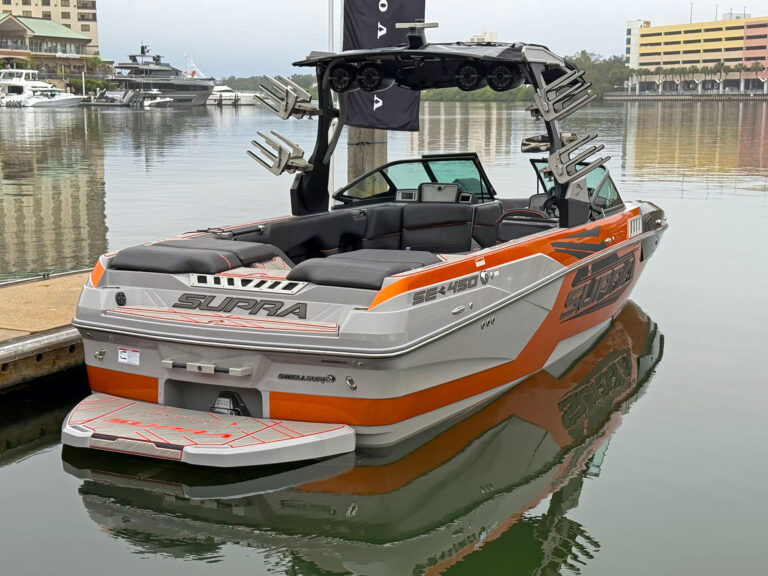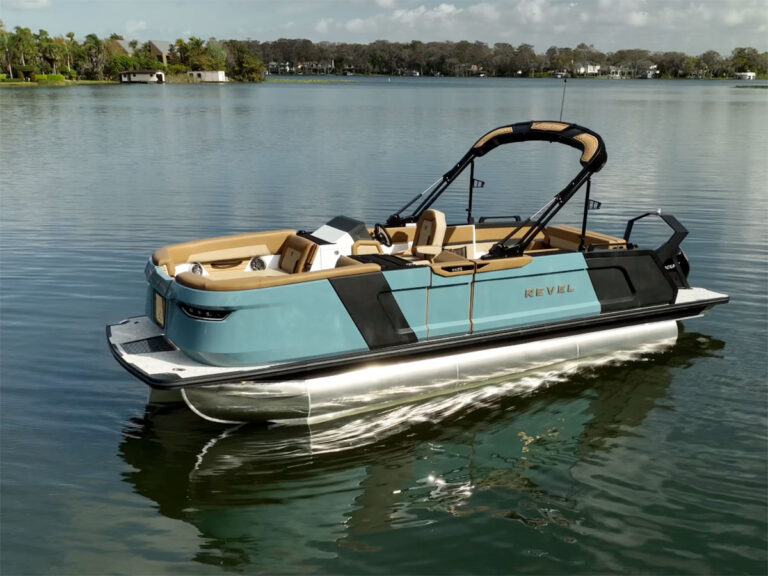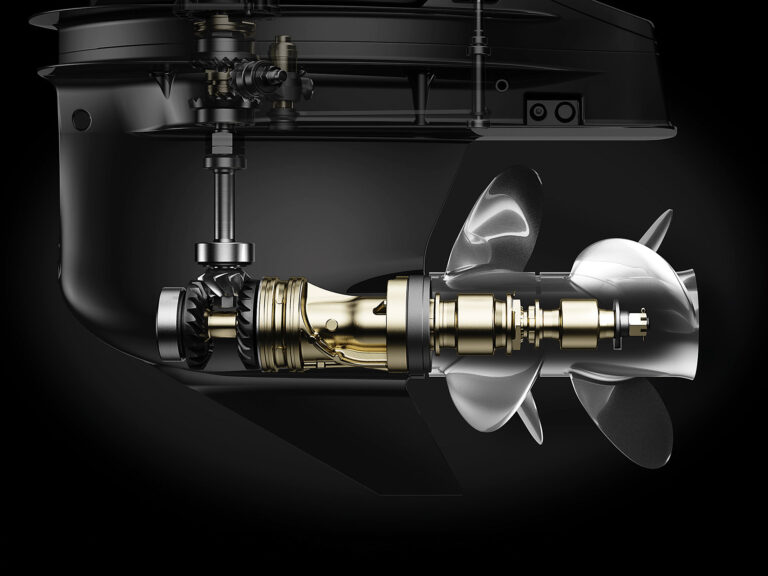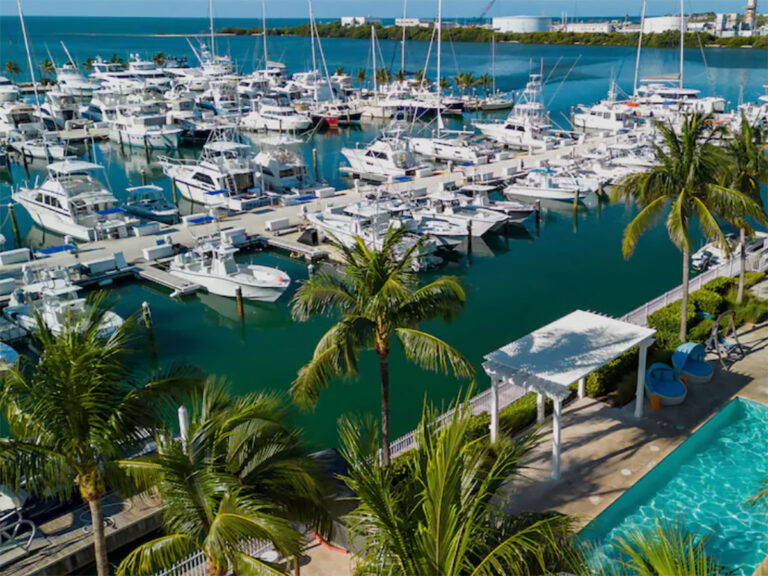
With wire nippers poised over a pair of wires, my head awkwardly angled beneath the opened helm station, I pondered the red and white strands like a bomb squad tech not altogether sure which to cut. We weren’t going to explode if I cut the wrong one, but we could blow our chances at being the first electric boat in the Lake of the Ozarks Rescue Shootout in Missouri.
The boat was an older 23-foot Calypso center-console, restored and refitted to hold 560 pounds of battery plus a 150-pound battery brain. The motor was a Deep Blue 50 kW unit reprogrammed to generate 80 hp. It was all the product of the German engineer and genius behind Torqeedo electric propulsion, Christophe Ballin, CEO and co-founder. Steve Trkla (pronounced Turk-la, since I knew you’d ask), president of Torqeedo Inc. USA had hauled the boat to Missouri from Crystal River, Illinois, which is the Torqeedo headquarters in the United States.
We touched base via mobile phone as he and his brother John made their way south to Lake of the Ozarks—Sunrise Beach, to be exact. There, my brother Brent and I were getting our digs set up at Lakeview Condominiums, about a 20-minute ride from the Shootout’s headquarters at Captain Ron’s, a waterfront eatery on a long (and rare) straightaway near the Hurricane Deck Bridge on the winding Lake of the Ozarks.

“Randy, are you sure you want to run this thing out there this weekend?” Steve queried apprehensively.
“I do… unless you do,” I said, a little nervously. Secretly, I’d been jonesing for this shot, a chance to run in the storied Shootout that began decades ago when Lake of the Ozarks, nicknamed LOTO, was my home waters. I’d never even seen the Shootout while I lived there; in fact, I never witnessed it at all until many years later. For a moment I was afraid he’d want to drive, but at this moment I feared he might back out altogether.
“But these… other… boats… are fast!” he worried aloud.
“It’s OK, we only have to race against our class.” And I knew, so far anyway, even though we’d never break 100 miles per hour, nobody in our class was going faster than us.
The Lake Rescue Shootout isn’t really a race. Boats run against the clock, solo on a ¾-mile course, using a long raceway approach to get trimmed up and running before hitting the starting gate, where officials punch the clock at entry and stop it as contestants exit in full glory in front of thousands of boating fans stretched out along the racecourse, moored up in a mile-long chain. I just wanted the chance to run in front of the crowd, hear them cheer, and watch them wave from the corner of wind-teared eyes, going hair on fire—well, we weren’t going to go that fast. But that didn’t stop my inner Walter Mitty from imagining the spectacle of it.
We weren’t here to beat American Ethanol, the defending top gun of the entire shootout—that team could break 200 mph, on a good run. We weren’t here to beat Jim Dorris and PlayCraft pontoons. He’d proven his mettle—or metal—20 years ago in his record-breaking pontoons and continues to do so. This was a proving ground for new technology, and we were here to prove that electric-powered boats were not only here, they were also viable, fun, exhilarating and a big part of the future of boating.

LOA: 23’0″ | Beam: 6’8″ | Transom Width: 4’8″ | Draft: 8″ | Water Line Length: 19’2″ | Deadrise at Transom: 7 degrees | Hull Weight (approx.): 1,200 lb. | Max Horsepower: 50 (80 hp equivalent) Courtesy Brent Vance
Any boat in excess of 22 feet is qualified to race the clock in the Shootout, and that’s how we settled on a 23-foot center-console with a flat bottom and a slick, black electric outboard. But here I was in the Ozarks, poised with wire clippers, sweating in the humid heat of an August morning.
There was this glitch.
In Germany, electric propulsion is required to have a kill switch, but it requires the captain to strike it to isolate batteries and components as a fail-safe feature against runaway batteries, in case the extensive battery protection in both the lithium-ion batteries and the enormous brain run amok.
But in the U.S., a kill switch is a safety switch or a cutoff lanyard and is attached to the captain to stop the propulsion in case bumpy conditions threw him—me—overboard, a not-too-unlikely scenario in boats designed to go up to 200 mph and on lakes as notoriously rough as LOTO. Presently, this across-the-pond gap in communications between Germany and the U.S. had me sweating with clippers in hand.
Steve had a Torqeedo tech guy on the phone adding to the drama.
“Just cut either one,” the crackly voice on speaker phone said. “If it doesn’t work, solder it back together and cut the other one.”
Easy for him to say. We’d just bought the switch at Advantage Marine, and one of the techs there had loaned me his Snap-On clippers. Who loans out Snap-On tools or a solder gun and solder?
I cut the red one, wired the switch in, drilled a port for it in the dash, also with borrowed equipment, and damned if it didn’t work. Now we could pass inspection—the next hurdle in our race.

The day before, Steve had launched the boat for me, told me how fast I could expect it to go, and walked me through the controls, the throttle mechanism, and the way the Simrad Evo 12, which was trained to speak Torqeedo, would report the motor’s power output, battery levels and range at any given speed.
As I idled out of the no-wake zone from the ramp, the computer told me I could go at this speed for hours—about eight of them. When I broke the no-wake barrier, I powered up, sliding the electric throttle—a potentiometer, really—forward. It felt like a jet throttle, compact and smooth with just the right amount of friction for steady control. The motor whistled like a jet too, and the water shooshed past, making more sound than the motor. As my speed climbed, my range dropped—finally down to just 40 minutes at full speed, which was nowhere near 200 mph.
I experimented with trim and throttle, and coaxed 1 mph more out of it than was expected, and noticed how well the dory-shaped boat handled the LOTO chop. Leaning forward over the helm station added either a bit of speed or the illusion of it—so I leaned.
With practice behind us and now the kill switch installed, we headed to Captain Ron’s for final registration and an inspection by the race officials. I’d borrowed the required helmet—a motorcycle helmet—from Brent Vance. My Mustang inflatable life jacket was the only concession the officials made—it was stout, but not a 100-mph-impact protective model.
“How fast will you go?” the official asked me.
“Not that fast.”
Steve and I watched as the inspector went through the boat, handed us our race number and wished us luck. I headed up to the concession stand for refreshments, shaking my head that the official hadn’t checked my work on the kill switch. Steve raised an eyebrow that said without words, “All that sweating for nothing?”
When I came back with water, Steve grinned at me.
“He came back and made me demo the switch you installed.” I think Steve thought I had ratted us out to prove my point. I was glad I at least had water in my hand as proof of my intended mission.
It would be hours before our trial. We kept a racetrack radio on our belt, listening to them call the race-boat numbers. Most boats would go through the course in less than a minute, 30 seconds even, and needed substantially more time setting up the approach. I knew I wouldn’t need much runway to set up, but I hadn’t thought of how long we’d be on the course.
We walked the docks for a while checking out the who’s who of performance boating. Fountain was there—I ran into Martin Rusin, marketing guru with time under his belt at Monterey, Blackfin, Chaparral, and now his dream job at Fountain, Donzi and Baja. Jim Dorris was there with PlayCraft pontoons, with entries skippered by him, his wife and grandkids. Who wouldn’t want a NASCAR-looking pontoon proven in the famous LOTO Shootout?
Lake of the Ozark’s trooper and water patrolwoman Stacey Mosher (“Hitting LOTO,” May 2018) was there, volunteering to help move things along in the race. Bob May, of Bob’s No Wake Zone Radio and the voice of the LOTO Shootout, covered the blow by blows of entries, with pre- and post-race follow-up coverage that was as exciting as the Indy 500. Ron Dugan, of Captain Ron’s, kept the land-based operation steaming along, and fire chief Jeff Dorhauer and his wife, Diana, were operating the registration desk. This was an international event thanks to Torqeedo.
Our chase boat was faster-looking, a 1978 Glastron CVX 16 with a 115 hp Johnson outboard. It was ironic, a 40-year-old antique was the pit boat to a new-tech electric Shootout contestant. Brent was at the helm of it, with John and Steve Trkla accompanying him. With them in tow, I picked my way through the fans’ boats not yet tied into the raft-up, hunted down No. 58, the boat that came before me, and waited my turn. And waited.
American Ethanol had made its first run already—they’d be top gun again. Several other speedsters entered the ¾-mile course and exited about 12 seconds later.

Control system includes electronic battery monitoring, using GPS technology to measure speed, range at speed and more
40 minutes at full throttle
8 hours at slow speed Courtesy Torqeedo
It was finally my turn. I cinched down the helmet’s chin strap, tightened my Mustang life jacket, double-checked my safety lanyard, and eyeballed the Torqeedo electric kill switch, making a mental note: No matter what, don’t hit it, touch it or bump it.
The entry gate to the warmup stretch was a mile away. I had been drifting near the starting line and didn’t plan to use the warmup stretch. The last boat finally roared to the entry gate, got the green flag, and roared up the course lined by cheering spectators who weren’t remotely audible over the boat’s engines. There is a long stretch after the racecourse to let the boat settle down. Running it is like a cross between a NASCAR victory lap and cool-your-horse lap at the Kentucky Derby. Using it wasn’t mandatory, but I didn’t know that.
Finally, our number was called. I retuned the radio to hear the live coverage as I raced. The flag man waved the green at me furiously—maybe impatiently—and I throttled up, hitting maximum speed just at the starting line.
We had given Bob May some talking points on the Deep Blue electric powerplant. At 30 seconds into the course, Bob had used most of our material. They began ad-libbing generously about electric-powered boats. At 60 seconds, Bob noted they could go to a commercial break and return before I finished my run.

Not surprisingly, I could hear the crowd cheering as well. Nobody had seen this before, and they were sharing in history—for a long time. At around two minutes, I heard my name hollered from a bluff to my left—a testament to the quiet motor—looked up, and the official photographer was taking finish-line portraits. I entered the wind-down stretch. The race officials were calculating my top speed while I waved to the race fans.
Read Next: Will Electric Boats Catch On Soon?
Bob May was still ad-libbing about the Torqeedo as they waited for me to clear the track—something I could have done, had I known, as easily as I entered it. But, hey, this was the moment Steve Trkla, myself, and the engineers at Torqeedo had been preparing for a year, so I enjoyed the moment, or moments.
At 25 mph, Torqeedo and I were the slowest top gun in the 2018 LOTO Rescue Shootout.

